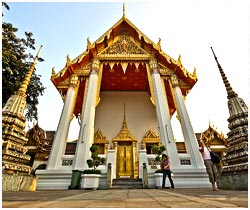Built approximately 200 years before Bangkok became Thailand's capital, it is claimed to be the oldest Wat of the country. However, today, the Wat shows no traces of its primeval history, owing to its major restoration works during the regimes of Rama I and Rama III. Leaving aside its antiquity, the focal attraction of the temple is its huge gold plated Reclining Buddha statue. It is 46 m long and 15 m high, with eyes and feet delicately carved with mother-of-pearl decoration. The feet of the statue also present the 108 holy characteristics of the true Buddha, in both Chinese and Indian styles.
 Apart from the stunning image of the Reclining Buddha, the temple
grounds exhibit more than 1000 Buddha images, most of them tracing back
their history to the former capitals of Ayuthaya and Sukhothai. The
entire temple compound of Wat Pho is bisected into two by Chetuphon
Road, with the northern side housing the temple hall (Bot) and other
attractions, like marble slabs, cenotaphs, statues, inscriptions, rock
gardens, chapels and belltowers. There is also a library with
magnificent figures and pagodas. The southern walled section, known as
'Tukgawee', is home to a working Buddhist monastery and a school.
Apart from the stunning image of the Reclining Buddha, the temple
grounds exhibit more than 1000 Buddha images, most of them tracing back
their history to the former capitals of Ayuthaya and Sukhothai. The
entire temple compound of Wat Pho is bisected into two by Chetuphon
Road, with the northern side housing the temple hall (Bot) and other
attractions, like marble slabs, cenotaphs, statues, inscriptions, rock
gardens, chapels and belltowers. There is also a library with
magnificent figures and pagodas. The southern walled section, known as
'Tukgawee', is home to a working Buddhist monastery and a school.Another characteristic of Wat Pho that marks its popularity is its association with Thai massages. The temple is considered as Thailand's first university and the bedrock of traditional Thai massages. Stone inscriptions on the temple walls narrate the rich heritage of Thai massage from the reign of King Rama III. The site was also a major study center of traditional medicine of Thailand. Today, the place offers a number of ancient healing massage therapies and offers courses and trainings on traditional massages and reflexology techniques of Thailand. Admission charges for entering the temple ground are 20 Baht per person.



